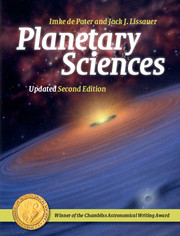Book contents
- Frontmatter
- Contents
- List of Tables
- Preface
- 1 Introduction
- 2 Dynamics
- 3 Solar Heating and Energy Transport
- 4 Planetary Atmospheres
- 5 Planetary Surfaces
- 6 Planetary Interiors
- 7 Magnetic Fields and Plasmas
- 8 Meteorites
- 9 Minor Planets
- 10 Comets
- 11 Planetary Rings
- 12 Extrasolar Planets
- 13 Planet Formation
- Appendix A List of Symbols Used
- Appendix B Acronyms Used
- Appendix C Units and Constants
- Appendix D Periodic Table of Elements
- Appendix E Observing Techniques
- Appendix F Interplanetary Spacecraft
- Appendix G Recent Developments in Planetary Sciences
- References
- Index
- Plate Section
- References
1 - Introduction
Published online by Cambridge University Press: 05 January 2015
- Frontmatter
- Contents
- List of Tables
- Preface
- 1 Introduction
- 2 Dynamics
- 3 Solar Heating and Energy Transport
- 4 Planetary Atmospheres
- 5 Planetary Surfaces
- 6 Planetary Interiors
- 7 Magnetic Fields and Plasmas
- 8 Meteorites
- 9 Minor Planets
- 10 Comets
- 11 Planetary Rings
- 12 Extrasolar Planets
- 13 Planet Formation
- Appendix A List of Symbols Used
- Appendix B Acronyms Used
- Appendix C Units and Constants
- Appendix D Periodic Table of Elements
- Appendix E Observing Techniques
- Appendix F Interplanetary Spacecraft
- Appendix G Recent Developments in Planetary Sciences
- References
- Index
- Plate Section
- References
Summary
Socrates: Shall we set down astronomy among the subjects of study?
Glaucon: I think so, to know something about the seasons, the months and the years is of use for military purposes, as well as for agriculture and for navigation.
Socrates: It amuses me to see how afraid you are, lest the common herd of people should accuse you of recommending useless studies.
Plato, The Republic VIIThe wonders of the night sky, the Moon and the Sun have fascinated mankind for many millennia. Ancient civilizations were particularly intrigued by several brilliant ‘stars’ that move among the far more numerous ‘fixed’ (stationary) stars. The Greeks used the word πλανητηζ, meaning wandering star, to refer to these objects. Old drawings and manuscripts by people from all over the world, such as the Chinese, Greeks, and Anasazi, attest to their interest in comets, solar eclipses, and other celestial phenomena.
The Copernican–Keplerian–Galilean–Newtonian revolution in the sixteenth and seventeenth centuries completely changed humanity's view of the dimensions and dynamics of the Solar System, including the relative sizes and masses of the bodies and the forces that make them orbit about one another. Gradual progress was made over the next few centuries, but the next revolution had to await the space age.
In October of 1959, the Soviet spacecraft Luna 3 returned the first pictures of the farside of Earth's Moon (Appendix F). The age of planetary exploration had begun. Over the next three decades, spacecraft visited all eight known terrestrial and giant planets in the Solar System, including our own. These spacecraft have returned data concerning the planets, their rings and moons. Spacecraft images of many objects showed details which could never have been guessed from previous Earth-based pictures. Spectra from ultraviolet to infrared wavelengths revealed previously undetected gases and geological features on planets and moons, while radio detectors and magnetometers transected the giant magnetic fields surrounding many of the planets.
- Type
- Chapter
- Information
- Planetary Sciences , pp. 1 - 21Publisher: Cambridge University PressPrint publication year: 2015



